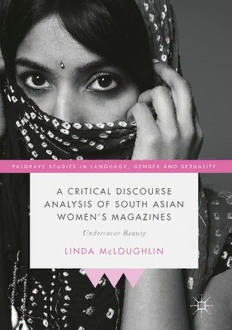
A critical discourse analysis of South Asian women's magazines: undercover beauty PDF
Preview A critical discourse analysis of South Asian women's magazines: undercover beauty
Palgrave Studies in Language, Gender and Sexuality Series Editors Helen Sauntson York St John University York, United Kingdom Allyson Jule School of Education Trinity Western University Langley, British Columbia, Canada Language,GenderandSexualityisanewserieswhichhighlightstherole of language in understanding issues, identities and relationships in relation to genders and sexualities. The series will comprise innovative, high quality research and provides a platform for the best contemporary fi scholarship in the eld of language, gender and sexuality. The series is interdisciplinary but takes language as it central focus. Contributions fi will be inclusive of both leading and emerging scholars in the eld. The seriesisinternationalinitsscope,authorshipandreadershipandaimsto draw together theoretical and empirical work from a range of countries and contexts. More information about this series at http://www.springer.com/series/15402 Linda McLoughlin A Critical Discourse Analysis of South ’ Asian Women s Magazines Undercover Beauty LindaMcLoughlin DepartmentofEnglish LiverpoolHopeUniversity Liverpool,UnitedKingdom PalgraveStudiesinLanguage,GenderandSexuality ISBN978-1-137-39877-2 ISBN978-1-137-39878-9(eBook) DOI10.1057/978-1-137-39878-9 LibraryofCongressControlNumber:2017938109 ©TheEditor(s)(ifapplicable)andTheAuthor(s)2017 Theauthor(s)has/haveassertedtheirright(s)tobeidentifiedastheauthor(s)ofthisworkinaccordance withtheCopyright,DesignsandPatentsAct1988. Thisworkissubjecttocopyright.AllrightsaresolelyandexclusivelylicensedbythePublisher,whether thewholeorpartofthematerialisconcerned,specificallytherightsoftranslation,reprinting,reuseof illustrations, recitation, broadcasting, reproduction on microfilms or in any other physical way, and transmission or information storage and retrieval, electronic adaptation, computer software, or by similarordissimilarmethodologynowknownorhereafterdeveloped. Theuseofgeneraldescriptivenames,registerednames,trademarks,servicemarks,etc.inthispublica- tiondoesnotimply,evenintheabsenceofaspecificstatement,thatsuchnamesareexemptfromthe relevantprotectivelawsandregulationsandthereforefreeforgeneraluse. Thepublisher,theauthorsandtheeditorsaresafetoassumethattheadviceandinformationinthis book are believed to be true and accurate at the date of publication. Neither the publisher nor the authorsortheeditorsgiveawarranty,expressorimplied,withrespecttothematerialcontainedherein orforanyerrorsoromissionsthatmayhavebeenmade.Thepublisherremainsneutralwithregardto jurisdictionalclaimsinpublishedmapsandinstitutionalaffiliations. Coverillustration:Indianwomanwearingheadscarf©TanyaConstantine/GettyImages Printedonacid-freepaper ThisPalgraveMacmillanimprintispublishedbySpringerNature TheregisteredcompanyisMacmillanPublishersLtd. Theregisteredcompanyaddressis:TheCampus,4CrinanStreet,London,N19XW,UnitedKingdom Acknowledgements First, I would like to thank all the women who participated in the focus group research. Without their very generous contributions, this book wouldnothavebeenpossible.Thankyouforgivingmetheopportunity tolearnmoreaboutyourculture,forthelaughterandfriendship.Ihope ff ‘ ’ my e orts to capture the essence of your voices meets with approval. I would like to thank Aimee Wilson of the Love & Etiquette Foundation ’ for putting me in touch with the womens organisations and to the key workers in each location, Naz, Yasmin, Mariam and Mevish who liaised with the women and kindly provided refreshments. I would like to thank the students in Bangalore for generously giving up their time and for engaging in discussion with such enthusiasm. I would like to thank the University for allowing the discussions to take place and Biju Chacko for setting up the groups. I would like to thank my colleagues in the English Department, Manel Herat, Salman Al-Azami, Lisa Nahajec and Ruth Kircher for their invaluable support. Special thanks to my head of department, Cindy Hamilton, who allowed me to accompany her on a visit to Bangalore on university business, which enabled the Indian focus group discussions to take place. I would like to thank Fazila Bhimji and Sariya Contractor whose work with Muslim women in Britain gave me inspiration. v vi Acknowledgements IwouldliketoacknowledgethesupportgivenbytheBritishAcademy who awarded a Leverhulme small grant to support some of the initial fi eldworkandenablethedisseminationworkshoptotakeplace.Iwould liketothanktheheadteacherofBlackburnHighSchool,MrsAtkinson, for allowing the school to be used as a venue for the dissemination workshop and deputy head Shazia Hussain for her kindness in helping to ensure that events ran smoothly on the day. I would like to thank all the workshop delegates whose attendance and participation began the processofintercommunitydialogue.Itismyhopethatthedialoguewill continue and that it will lead to better understanding of the needs of South Asian women living in the UK. I would also like to thank Chloe Fitzsimmons of Palgrave Macmillan for supporting this book project and seeing it through to fruition. I would like to thank the series editors, Helen Sauntson and Allyson Jule for careful reading of the manuscript. I would like to thank Ms. J. Wimal of Jayson Emerald Media Corporation Ltd copyright holder of the Front Cover Asian Woman, Winter 2011, issue 49. John, my husband and my children Sarah and Nick, thank you for your constant encouragement and unwavering support. Contents 1 Introduction 1 – 2 Orienting the Reader The Legacy of Colonialism and Cultural Imperialism 33 – fi 3 The Aesthetics of Beauty Commodi cation 55 – fi 4 For the Woman Who Wants the World Commodi ed Feminism 87 – 5 East Meets West Cultural Hybridity 121 ’ ’ 6 Mens Voices in Womens Magazines 151 ’ 7 Readers Responses: Multi-vocal Expressions of Identity 179 8 Conclusion 247 Appendix 255 Further Readings 257 Index 259 vii List of Figures Fig. 1.1 ‘Mancrafted’ Phive Rivers advertisement 11 Fig. 2.1 Kent Ro Water Purifiers advertisement 47 Fig. 3.1 Lightenex Pharmaclinix advertisement 58 Fig. 5.1 ‘Front cover’ Asian Woman 128 ix 1 Introduction ‘ Chapkis (1986) claims that female beauty is becoming an increas- ingly standardized quality throughout the world. A standard so strikingly white, Western and wealthy it is tempting to conclude ’ there must be a conscious conspiracy afoot (36). Female beauty is fi ’ a signi cant aspect of all women s lifestyle magazines, no doubt due to the revenue generated by advertisements for products which promise to aid in the achievement of this globalized beauty aes- ’ thetic. Without question, women s magazines perpetuate a widely ’ fi held cultural belief that a woman s worth is de ned in terms of her appearance. However, this is particularly salient in Asia, since according to Glenn (2008): regardless of the origins of color consciousness in India, the preference for light skin seems almost universal today, and in terms of sheer numbers, India and Indian diasporic communities around the world constitute the largest market for skin lighteners. The major consumers of these products in South Asian communities are women between the ages of 16 and 35. (289) © The Author(s) 2017 1 L. McLoughlin, A Critical Discourse Analysis of South Asian Women’s Magazines, Palgrave Studies in Language, Gender and Sexuality, DOI 10.1057/978-1-137-39878-9_1
